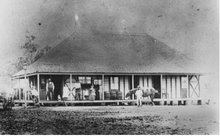When we lived in the States, one of the things that people seemed to find most fascinating was that our seasons here are “backwards.” One of the things that can be most disconcerting is that so many events of our lives are associated with the weather. I’ve mentioned before the disorienting experience for northerners of having warm Christmases. Even stranger to some people is have birthdays in different seasons after moving. One of my children was born in the heat and humidity of a Minnesota summer and now has a birthday in the cool freshness of winter. She doesn’t remember having hot birthdays, but others have told me of their disorientation as adults experiencing birthdays in a season different to their previous experience.
The southern school year starts in late January and concludes just before Christmas in contrast to the northern September to July year. Christmas is the jewel of our extended summer break – just squeezing into the northern term break . I still get anxious at the first touch of autumn weather in anticipation of the start of the academic year. Only now, I am getting twitchy in April instead of September. And of course, my days are no longer regulated by the academic calendar. Nonetheless my autumnal dreams are of getting to classes on time and working out my schedule.
If I really wanted to disconcert less-well-informed American friends I would point out that we have different constellations as well. This worked best with those who believed that we were Austrian, skied a lot and had surprisingly good English (take a bow, George W. who came to Australia, talked about the brave Austrian troops in Iraq and how pleased he was to have been invited to the OPEC meeting. If only Australia could invite people to OPEC, let alone be a member).
The feature of our southern skies is the Southern Cross, which figures so strongly in our national identifiers of flag, badge and sporting logos. Its symbolism is shared with New Zealand, and its presence with the rest of the southern hemisphere, but we feel very strongly that it is our constellation.
Edward Allchurch wrote in his diary in 1866: “We can now see the Southern Cross very plain.” He wrote this before the ship rounded the Cape of Good Hope, yet saw it as a sign of their new life and changed circumstances. I stood at my kitchen window the other night watching the Southern Cross low on the horizon and thinking about how strange it would be to look at a night sky totally different from any seen before. Yet, for people used to living in towns, perhaps even the enormity of the clear night skies would have been unexpected, let alone the configurations of the stars. How many people would have been entranced by the spectacle of stars and cloudburst Milky Way and how many scurried inside away from the unfamiliar glories?
Wednesday, 19 September 2007
Seeing the Southern Cross
Labels:
Australia,
constellations,
everyday life,
history,
migration,
weather
Subscribe to:
Post Comments (Atom)

No comments:
Post a Comment